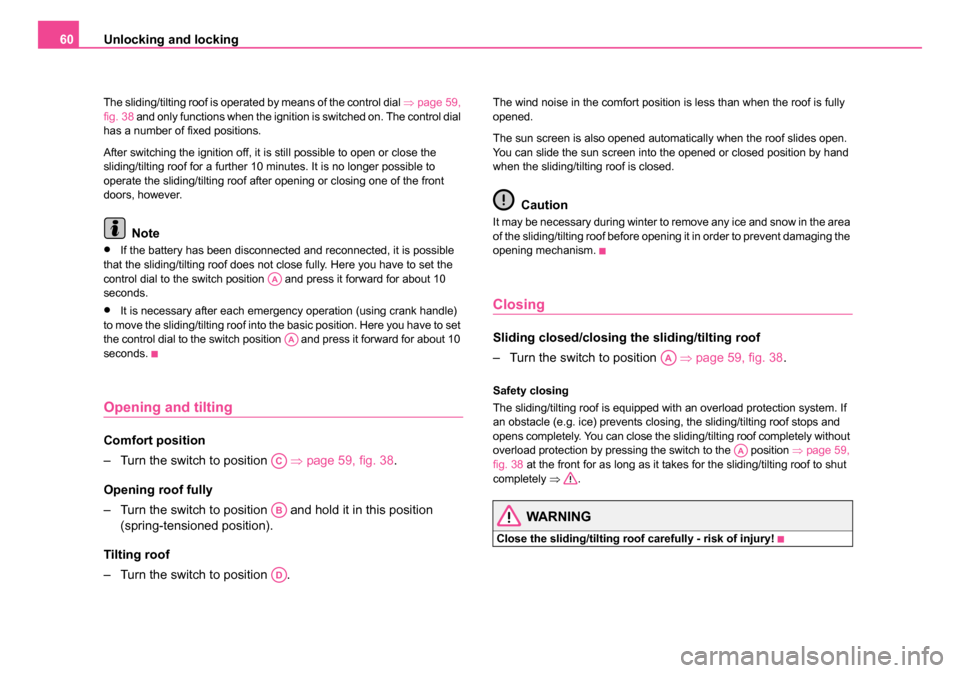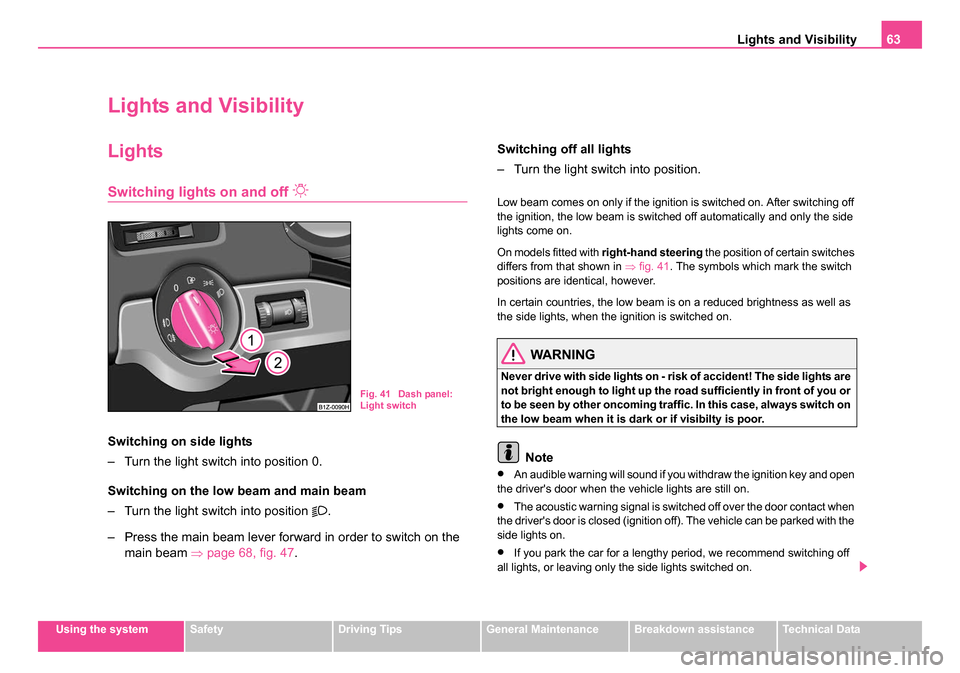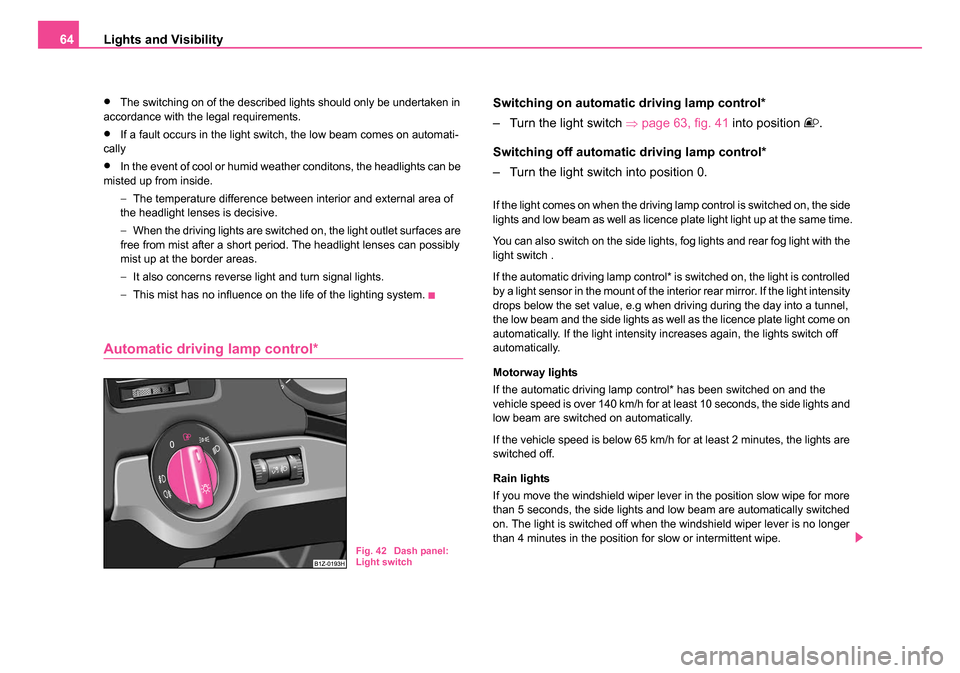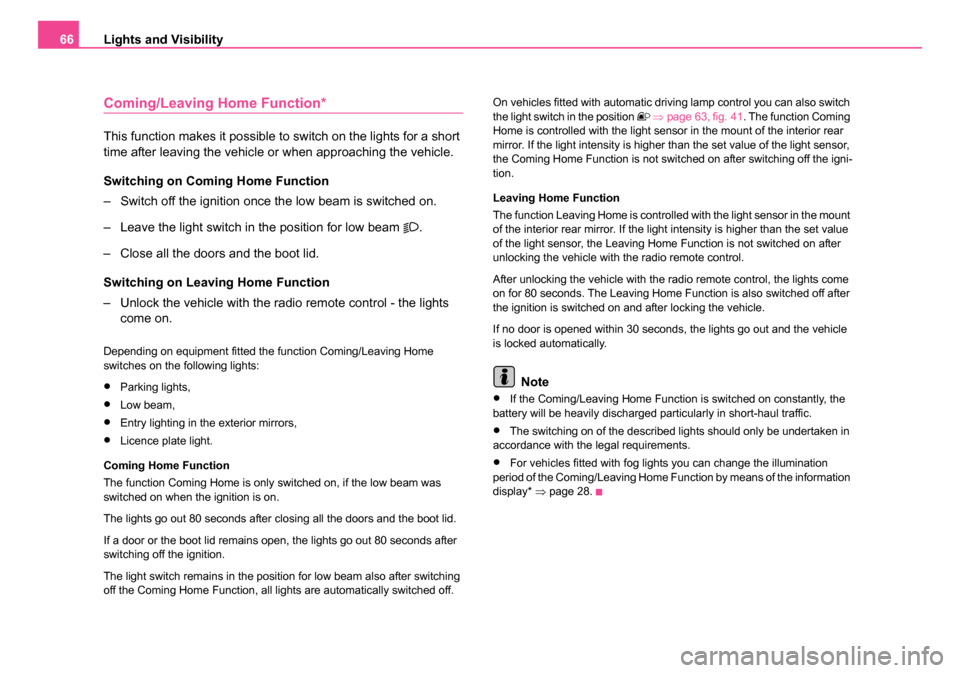SKODA OCTAVIA 2005 1.G / (1U) Repair Manual
Manufacturer: SKODA, Model Year: 2005, Model line: OCTAVIA, Model: SKODA OCTAVIA 2005 1.G / (1U)Pages: 315, PDF Size: 11.8 MB
Page 61 of 315

Unlocking and locking
60
The sliding/tilting roof is operated by means of the control dial ⇒page 59,
fig. 38 and only functions when the ignition is switched on. The control dial
has a number of fixed positions.
After switching the ignition off, it is still possible to open or close the
sliding/tilting roof for a further 10 minutes. It is no longer possible to
operate the sliding/tilting roof after opening or closing one of the front
doors, however.
Note
•If the battery has been disconnected and reconnected, it is possible
that the sliding/tilting roof does not close fully. Here you have to set the
control dial to the switch position and press it forward for about 10
seconds.
•It is necessary after each emergency operation (using crank handle)
to move the sliding/tilting roof into the basic position. Here you have to set
the control dial to the switch position and press it forward for about 10
seconds.
Opening and tilting
Comfort position
– Turn the switch to position ⇒page 59, fig. 38 .
Opening roof fully
– Turn the switch to position and hold it in this position (spring-tensioned position).
Tilting roof
– Turn the switch to position .
The wind noise in the comfort position is less than when the roof is fully
opened.
The sun screen is also opened automatically when the roof slides open.
You can slide the sun screen into the opened or closed position by hand
when the sliding/tilting roof is closed.
Caution
It may be necessary during winter to remove any ice and snow in the area
of the sliding/tilting roof before opening it in order to prevent damaging the
opening mechanism.
Closing
Sliding closed/closing the sliding/tilting roof
– Turn the switch to position ⇒page 59, fig. 38 .
Safety closing
The sliding/tilting roof is equipped with an overload protection system. If
an obstacle (e.g. ice) prevents closing, the sliding/tilting roof stops and
opens completely. You can close the sliding/tilting roof completely without
overload protection by pressing the switch to the position ⇒page 59,
fig. 38 at the front for as long as it takes for the sliding/tilting roof to shut
completely ⇒.
WARNING
Close the sliding/tilting roof carefully - risk of injury!
AA
AA
AC
AB
AD
AA
AA
s24s.book Page 60 Thursday, November 24, 2005 12:27 PM
Page 62 of 315

Unlocking and locking61
Using the systemSafetyDriving TipsGeneral MaintenanceBreakdown assistanceTechnical Data
Convenience operation
You can also close an open sliding/tilting roof from the outside.
– Turn the key in the lock of the driver door into the closing posi-
tion or press the closing button of the radio remote control until
the sliding/tilting roof is closed ⇒.
The closing process stops when one releases the key or the closing
button.
WARNING
Close the sliding/tilting roof carefu lly - risk of injury! The overload
protection system does not function with the convenience
closing.
Emergency operation
You can close the sliding/tilting roof by hand if the system is
defect.
Fig. 39 Detail of the
headliner: point for
positioning screw-
driver
Fig. 40 Detail of the
headliner: Emergency
operation
s24s.book Page 61 Thursday, November 24, 2005 12:27 PM
Page 63 of 315

Unlocking and locking
62
– Position the flat blade of a screwdriver carefully against the rear edge of the cover of the power roof drive ⇒page 61,
fig. 39.
– Pull the cover down.
– Take the crank handle out of the inside of the cover.
– Press the crank handle fully into the hexagon hole ⇒page 61, fig. 40 .
– Hold the crank pressed and turn it - the roof closes.
– Insert the crank handle into the cover again.
– Press on the cover again by first of all inserting the plastic lugs and then pushing the cover up.
– Have the fault rectified by a specialist workshop.
Note
It is necessary after each emergency operation (using crank handle) to
move the sliding/tilting roof into the basic position. Here you have to press
the control dial forward to switch position ⇒page 59, fig. 38 for about
10 seconds.
A1A2
AA
s24s.book Page 62 Thursday, November 24, 2005 12:27 PM
Page 64 of 315

Lights and Visibility63
Using the systemSafetyDriving TipsGeneral MaintenanceBreakdown assistanceTechnical Data
Lights and Visibility
Lights
Switching lights on and off
Switching on side lights
– Turn the light switch into position 0.
Switching on the low beam and main beam
– Turn the light switch into position
.
– Press the main beam lever forward in order to switch on the main beam ⇒ page 68, fig. 47 . Switching off all lights
– Turn the light switch into position.
Low beam comes on only if the ignition is switched on. After switching off
the ignition, the low beam is switched off automatically and only the side
lights come on.
On models fitted with
right-hand steering the position of certain switches
differs from that shown in ⇒fig. 41 . The symbols which mark the switch
positions are identical, however.
In certain countries, the low beam is on a reduced brightness as well as
the side lights, when the ignition is switched on.
WARNING
Never drive with side lights on - risk of accident! The side lights are
not bright enough to light up the road sufficiently in front of you or
to be seen by other oncoming traffic. In this case, always switch on
the low beam when it is dark or if visibilty is poor.
Note
•An audible warning will sound if you withdraw the ignition key and open
the driver's door when the vehicle lights are still on.
•The acoustic warning signal is switched off over the door contact when
the driver's door is closed (ignition off). The vehicle can be parked with the
side lights on.
•If you park the car for a lengthy period, we recommend switching off
all lights, or leaving only the side lights switched on.
Fig. 41 Dash panel:
Light switch
s24s.book Page 63 Thursday, November 24, 2005 12:27 PM
Page 65 of 315

Lights and Visibility
64
•The switching on of the described lights should only be undertaken in
accordance with the legal requirements.
•If a fault occurs in the light switch, the low beam comes on automati-
cally
•In the event of cool or humid weather conditons, the headlights can be
misted up from inside.
−The temperature difference between interior and external area of
the headlight lenses is decisive.
− When the driving lights are switched on, the light outlet surfaces are
free from mist after a short period. The headlight lenses can possibly
mist up at the border areas.
− It also concerns reverse light and turn signal lights.
− This mist has no influence on the life of the lighting system.
Automatic driving lamp control*
Switching on automatic driving lamp control*
– Turn the light switch ⇒page 63, fig. 41 into position
.
Switching off automatic driving lamp control*
– Turn the light switch into position 0.
If the light comes on when the driving lamp control is switched on, the side
lights and low beam as well as licence plate light light up at the same time.
You can also switch on the side lights, fog lights and rear fog light with the
light switch .
If the automatic driving lamp control* is switched on, the light is controlled
by a light sensor in the mount of the interior rear mirror. If the light intensity
drops below the set value, e.g when driving during the day into a tunnel,
the low beam and the side lights as well as the licence plate light come on
automatically. If the light intensity increases again, the lights switch off
automatically.
Motorway lights
If the automatic driving lamp control* has been switched on and the
vehicle speed is over 140 km/h for at least 10 seconds, the side lights and
low beam are switched on automatically.
If the vehicle speed is below 65 km/h for at least 2 minutes, the lights are
switched off.
Rain lights
If you move the windshield wiper lever in the position slow wipe for more
than 5 seconds, the side lights and low beam are automatically switched
on. The light is switched off when the windshield wiper lever is no longer
than 4 minutes in the position for slow or intermittent wipe.
Fig. 42 Dash panel:
Light switch
s24s.book Page 64 Thursday, November 24, 2005 12:27 PM
Page 66 of 315

Lights and Visibility65
Using the systemSafetyDriving TipsGeneral MaintenanceBreakdown assistanceTechnical Data
WARNING
The automatic driving lamp control only operates as a support. The
driver is not released from his responsibility to inspect the light
and if necessary to switch on the light depending on the light
conditions. The light sensor cannot detect for example rain or
snow. Always switch on the low beam
under these conditions
as well as when driving in the dark!
Note
•Do not affix any stickers in front of the light sensor, so that you do not
impair its function or put it out of operation.
•The same principles as for using the automatic driving lamp control
also apply to the light which is switched on manually ⇒page 63.
Fog lights*
Switching on the fog lights
– First of all turn the light switch ⇒fig. 43 into position
or .
– After this pull the light switch out to the first detent .
When the fog lights are operating, the symbol next to the light switch is
illuminated more intensely.
The rear fog light
Switching on the rear fog light
– First of all turn the light switch ⇒fig. 43 into position
or .
– Pull the light switch out to the second detent .
The rear fog light warning light ⇒ page 30 lights up in the instrument
cluster when the fog light is switched off.
Only the rear fog light of the trailer lights up automatically when you are
towing a trailer using a factory-fitted towing device which is fitted with
the rear fog light.
The rear fog light is located in the rear light array on the driver's side.
Caution
The rear fog light should only be switched on if visibility is particularly poor
(conform with any varying legal provisions) to avoid dazzling vehicles
behind your vehicle.
Fig. 43 Dash panel:
Light switch
A1
A2
s24s.book Page 65 Thursday, November 24, 2005 12:27 PM
Page 67 of 315

Lights and Visibility
66
Coming/Leaving Home Function*
This function makes it possible to switch on the lights for a short
time after leaving the vehicle or when approaching the vehicle.
Switching on Coming Home Function
– Switch off the ignition once the low beam is switched on.
– Leave the light switch in the position for low beam
.
– Close all the doors and the boot lid.
Switching on Leaving Home Function
– Unlock the vehicle with the radio remote control - the lights come on.
Depending on equipment fitted the function Coming/Leaving Home
switches on the following lights:
•Parking lights,
•Low beam,
•Entry lighting in the exterior mirrors,
•Licence plate light.
Coming Home Function
The function Coming Home is only switched on, if the low beam was
switched on when the ignition is on.
The lights go out 80 seconds after closing all the doors and the boot lid.
If a door or the boot lid remains open, the lights go out 80 seconds after
switching off the ignition.
The light switch remains in the position for low beam also after switching
off the Coming Home Function, all lights are automatically switched off. On vehicles fitted with automatic driving lamp control you can also switch
the light switch in the position
⇒ page 63, fig. 41 . The function Coming
Home is controlled with the light sensor in the mount of the interior rear
mirror. If the light intensity is higher than the set value of the light sensor,
the Coming Home Function is not switched on after switching off the igni-
tion.
Leaving Home Function
The function Leaving Home is controlled with the light sensor in the mount
of the interior rear mirror. If the light intensity is higher than the set value
of the light sensor, the Leaving Home Function is not switched on after
unlocking the vehicle with the radio remote control.
After unlocking the vehicle with the radio remote control, the lights come
on for 80 seconds. The Leaving Home Function is also switched off after
the ignition is switched on and after locking the vehicle.
If no door is opened within 30 seconds, the lights go out and the vehicle
is locked automatically.
Note
•If the Coming/Leaving Home Function is switched on constantly, the
battery will be heavily discharged particularly in short-haul traffic.
•The switching on of the described lights should only be undertaken in
accordance with the legal requirements.
•For vehicles fitted with fog lights you can change the illumination
period of the Coming/Leaving Home Function by means of the information
display* ⇒page 28.
s24s.book Page 66 Thursday, November 24, 2005 12:27 PM
Page 68 of 315

Lights and Visibility67
Using the systemSafetyDriving TipsGeneral MaintenanceBreakdown assistanceTechnical Data
Instrument lighting*
You can adjust the brightness of the instrument lighting.
Instrument lighting
– Switch on the light.
– Turn the control dial ⇒fig. 44 to the desired intensity of the
instrument lighting
5).
Headlight range adjustment
Once the low beam is switched on you can then adapt the
range of the headlights to the load of the vehicle.
– Turn the control dial ⇒fig. 45 until you have adjusted the low
beam so that oncoming traffic is not dazzled.
Settings
The positions correspond approximately to the following vehicle loads:
Front seats occupied, luggage compartment empty.
All seats occupied, luggage compartment empty.
All seats occupied, luggage compartment laden.
Driver seat occupied, luggage compartment laden.
Caution
Set the headlight beam adjustment in such a way as to avoid dazzling
oncoming traffic.5)On the information display* ⇒page 23 the intensity of the lighting is automatically
set. The setting using the control dial ⇒fig. 44 is only possible when driving in the
dark.
Fig. 44 Dash panel:
Instrument lighting
Fig. 45 Dash panel:
Lights and Visibility
A-
A1
A2
A3
s24s.book Page 67 Thursday, November 24, 2005 12:27 PM
Page 69 of 315

Lights and Visibility
68
Note
Headlights fitted with Xenon bulbs* adapt automatically to the load and
driving state of the vehicle (e.g. accelerating, braking) when the ignition is
switched on and when driving.
Switch for hazard warning lights
– Press switch ⇒ fig. 46 to switch the hazard warning light
system on or off.
All the turn signal lights on the vehicle flash at the same time when the
hazard warning light system is switched on. The indicator light for the turn
signals and the indicator light in the switch also flash at the same time.
You can also switch on the hazard warning light system if the ignition is
switched off. The hazard warning light system is switched on automatically if an airbag
is deployed in the event of an accident.
Please comply with any legal requirements when using the hazard
warning light system.
Note
Switch on the hazard warning light system if, for example:
•you encounter traffic congestion,
•your vehicle breaks down or an emergency situation occurs.
Turn signal and main beam lever
The parking lights and headlight flasher are also switched
on and off using the turn signal and main beam lever.
Fig. 46 Dash panel:
Switch for hazard
warning lights
Fig. 47 Turn signal
and main beam lever
s24s.book Page 68 Thursday, November 24, 2005 12:27 PM
Page 70 of 315

Lights and Visibility69
Using the systemSafetyDriving TipsGeneral MaintenanceBreakdown assistanceTechnical Data
The turn signal and main beam lever perform the following func-
tions:
Right
and left turn signal light
– Push the lever upwards or downwards ⇒page 68, fig. 47 .
– If you only wish to flash three times* (the so-called conven- ience turn signal), push the lever briefly up to the upper or
lower pressure point and release it.
– Turn signal for changing lanes, in order to only flash briefly - move the lever up or down to the pressure point and hold it in
this position.
Main beam
– Switch on the low beam.
– Push the lever forwards.
– Pull the lever back into the initial position in order to switch the main beam off again.
Headlight flasher
– Pull on the lever of the steering wheel (sprung position) - the main beam and warning light in the instrument cluster come
on.
Parking light
– Switch off the ignition.
– Push the lever up or down - the right-hand or left-hand parking light is switched on.
Information concerning the function of the lights.
•The turn signal system only operates when the ignition is switched
on. The corresponding indicator light or in the instrument cluster also
flashes.
•The turn signal is automatically cancelled after negotiating a curve.
•The indicator light flashes at twice its normal rate if a bulb of the turn
signal light fails.
•The side light and rear light on the appropriate side of the vehicle are
switched on when the parking light is selected. The parking light function
only operates if the ignition is switched off.
•An acoustic warning signal will sound when the driver's door is opened
if the lever is not in the middle position after removing the ignition key. The
acoustic warning signal will stop just as soon as the driver's door is closed.
Caution
Use main beam or the headlight flasher only if this does not risk dazzling
other road users.
Note
•Use only in accordance with the legal requirements the described
lighting and signal systems.
s24s.book Page 69 Thursday, November 24, 2005 12:27 PM